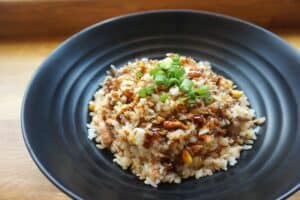
Can I Give My Dog Yellow Rice?
Let’s continue our nutritional questions and advices! After raw meat, asparagus, guava, and more, it’s time to talk… about yellow rice! So, we all know

We all love our dogs and want to give them the best life. But the amount of choices when it comes to dog food makes it super hard to figure out what you need. It isn’t always easy to identify the best food for our dog.
Studies have shown that the primary ingredient in dog food should be meat-based protein, not corn meal, flour or corn gluten meal. A better quality dog food results in a healthier coat, fewer digestive problems and firmer stools.
There are many varieties of dog food to choose from. The three most popular types of dog foods are dry, semi-moist and canned products. Usually dog food made from natural ingredients will have soft earth tones and contain no preservatives, artificial colors and flavors.

Raw dog food is becoming more popular. The diet costs more than traditional dog food.
Many natural dog foods contain only fresh, natural and wholesome ingredients for your dog. Not only are the protein ingredients digestible, but the carbohydrates in the dog food are digestible. Natural dog food has 100% nutritional value which is important for healthy strong dogs. There are also ingredients in natural dog food that really help the health of your dog’s skin and also your dog’s coat. One of the main draw backs of natural dog food is that it has a shorter shelf life and may spoil before it is used.
People sometimes just pick the first dog food bag they see at the store. The term that comes up a lot about dog food is human grade. Human grade implies that the dog food is good enough for us to eat. Many commercial dog foods are made from materials unusable or less desirable for human consumption. Often the meat that is used in dog food is of a quality considered unfit for humans to eat. Careful, this does not mean that the dog food is good for your dog just because it is “human grade”. Do your homework before buying.

What’s better: “rich in antioxidants,” “highly digestible,” “Omega-3 fatty acids” or “Ultra Premium Formula”? What we ended up doing is going the semi-scientific route: conduct a simple dog food comparison to determine which foods best fit our dog’s requirements and our preferences. Some foods offer much greater convenience than raw frozen food that has to thaw out. Our dog used to refuse to eat before nightfall. It was a disgusting mess. Convenience aside, the best food to give your dog depends not on the brand on the quality, the ingredients and your dog’s special requirements (age, size, allergies, etc.).
The vast majority of dog owners go for dry dog food. There are many brands to choose from. Dry dog food consists of kibble typically made from one primary protein. More specifically, the main ingredient is usually a meat byproduct that’s been processed, dried and sold in packs or bags for easy dispensing. Meat byproducts are far cheaper than meat. This is why it’s so popular among supermarket dog food brands.
A good high quality dry dog food will work out to be more economical than the generic brands even though they cost more per pound. A vast majority of dog owners go for dry dog food for its convenience and ease of storage.
More natural, “premium” dog food is gaining popularity. With higher quality nutritious ingredients are used to manufacture the dog. For the most part, they contain no artificial coloring and preservatives and are chock-full of vitamins and minerals. Although it’s more expensive, you can feed your dog less because it’s more nutritionally dense.

Let’s continue our nutritional questions and advices! After raw meat, asparagus, guava, and more, it’s time to talk… about yellow rice! So, we all know

As our loyal companions age, their dietary needs change. This is what this article is about: what is the Healthiest Dog Food for Senior Dogs?
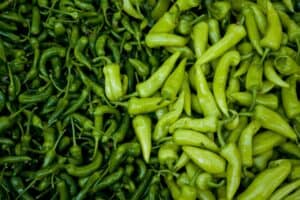
Picture this: you are enjoying banana peppers, and suddenly, you notice that your dog is sitting next to you intensely looking at you. Since you

There’s been a growing trend among pet owners towards raw or “Biologically Appropriate Raw Food” (BARF) diets for their dogs. This has prompted a widespread
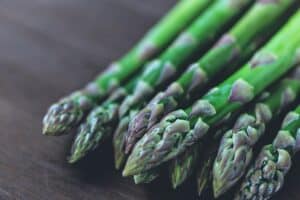
Asparagus is a green vegetable known for its distinct flavor and impressive nutritional profile. But for dog owners, the usual question arises: can dogs eat
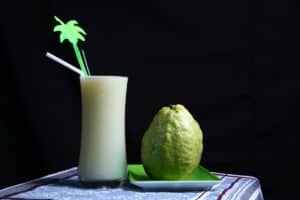
Guava is a tropical fruit renowned for its nutrient richness. It is packed with vitamins A and C, dietary fiber, and a cocktail of antioxidants,

We tested Nutrience Infusion, Canadian made small breeds dog food, with our small dachshund. Discover our review right now.
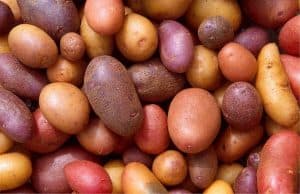
How healthy are potatoes for dogs? Are the skins ok for dogs to eat? How about roasted, mashed, fried, boiled, or raw potatoes? What about yams? Check out our FAQ page for answers.

Before we go any further, you should always keep in mind that most human dishes are not good for dogs. Most of the snacks and

Is it okay for dogs to eat pizza dough, hamburgers, lasagna, spaghettios, or ramen noodles? What about raw hamburger? Check our FAQ page for answers.